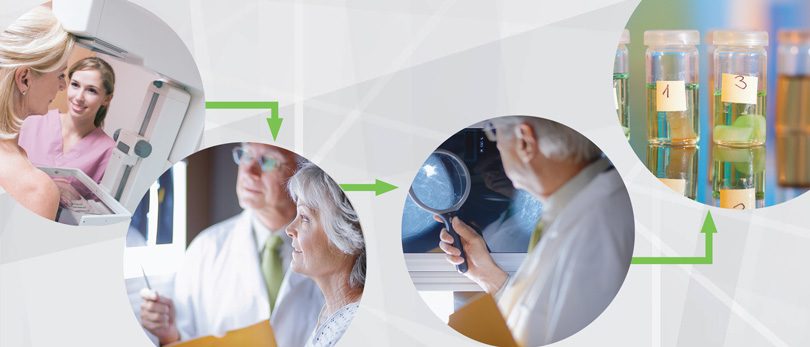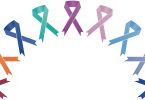Although about 37 million mammograms are performed annually, only about 232,000 women were diagnosed with breast cancer in 2013. But this fact is of little comfort if you are one of the patients with a “suspicious” mammogram. What happens next? How long until you know for sure?
The clinicians at the UHS Breast Center know that a suspicious mammogram can cause fear and anxiety. That’s why the center brings together the entire breast care team under one roof, delivering the most coordinated care available. One of the main goals of the Breast Center is to give patients a clear diagnosis or a clean bill of health in the shortest amount of time possible, leaving less time for worry.
 Screening Mammogram
Screening Mammogram
A screening mammogram is a basic mammogram that most women get annually, often beginning around age 40. Screening mammograms at the Breast Center at UHS Vestal can be scheduled every weekday, as well as Saturdays. Late appointments are available on Tuesdays. Hours at other locations vary.
 Interpretation
Interpretation
Each mammogram is read on-site by a radiologist, a physician who is trained to interpret diagnostic breast procedures and reads thousands of breast studies yearly. Mammograms are usually read within 24 hours.
Under suspicion
If you have a screening mammogram at a non-UHS facility that shows suspicious results, requesting a diagnostic mammogram at UHS is simple. You will only need to sign a release form that allows us to request your mammogram results from the other facility.
Negative
If there are no signs of breast cancer, you are notified quickly, and advised to schedule another screening mammogram in one to two years.
Positive
If the radiologist sees something “suspicious” on your mammogram, you will be called by the center within 24 hours for a diagnostic mammogram and possible breast ultrasound.
 Diagnostic mammogram and breast ultrasound
Diagnostic mammogram and breast ultrasound
Appointments for diagnostic mammograms and ultrasound are available within 24–48 hours after you are notified of a suspicious finding. A diagnostic mammogram is a more thorough and detailed mammogram that requires additional images. An ultrasound will determine if the abnormality is a cyst or a solid mass. You will also meet with a nurse coordinator during this appointment (see sidebar). The radiologist will quickly interpret the studies, and a nurse will give you results before you leave.
Every step of the way
A nurse coordinator in the UHS Breast Center will give you information and support from the moment you learn that you may have a suspicious finding. She helps coordinate your care from diagnostic mammogram to post-surgical care. You’ll never have to wonder, “What happens now?” because your nurse coordinator will be with you every step of the way. Read more about nurse coordination.
Negative
The additional images and ultrasound allow the radiologist to determine your mammogram is now normal. A six month follow-up may be suggested if there is a new benign finding to assess long-term stability.
Positive
If your diagnostic mammogram or ultrasound show a suspicious abnormality, you will schedule an appointment with a breast surgeon — usually available that same day — who will recommend a biopsy.
 Needle biopsy
Needle biopsy
Diagnostic evaluation results are known the same day and, when a biopsy or surgical consult is necessary, appointments are available the same day if the patient desires. All biopsies are processed in-house and read by our fellowship-trained pathologist, so results are ready within 24–48 hours.
Negative
Your results indicate you require no immediate treatment, but continued monitoring may be recommended.
Positive
Once a diagnosis of cancer is made, your breast care team will meet with you to plan a strategy of surgery, radiation and/or chemotherapy that is right for you.
Meet Dr. Ranade
The UHS Breast Center is pleased to announce the addition of Aditi Ranade, MD, to its staff. Dr. Ranade is an expert in breast pathology — the diagnosis of breast disease by evaluating breast tissue that is suspected of being malignant. She is a fellowship-trained breast pathologist, the first one working in the Binghamton area.
She comes to the UHS Breast Center after completing a fellowship in breast and gynecological pathology at the University of Pittsburgh and a fellowship in oncologic surgical pathology at Memorial Sloan-Kettering Cancer Center in New York City. She has also been a clinical instructor of breast and gynecological pathology at Magee – Women’s Hospital, University of Pittsburgh.
The addition of Dr. Ranade to the UHS Breast Center staff further enhances the comprehensive care available to patients in the Southern Tier. Dr. Ranade is expert at diagnosing breast disease, and has the advantage of the on-site, advanced diagnostic technology at the UHS Breast Center.
GET CHECKED.
Mammography is available at four UHS locations. Visit the breast health hub on the UHS website to get more information about breast cancer screening, diagnosis and treatment at UHS.







